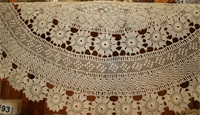
Applicants:
Lapithos Municipality, Kilani Villagers Association, Omodos Community Council
Communities Concerned - Bearers of the element:
Kilani and Omodos Community Councils, Lapithos Municipality.
Kilani Villagers Association, Lapithos Cultural Foundation, “Lapithos” Refugee Association, Church Committee of the Omodos Holy Cross Church, groups of lace-makers, owners of traditional lace workshops.
Domain of Intangible Cultural Heritage:
Traditional craftsmanship
Date of inscription:
2015
Geographical location and range of the element:
Today the art of “pipilla” needle lace-making is carried on by the Kilani, Lapithos and Omodos lace-makers. In the past the main lace-making centres also used to be in Nicosia, Larnaca, Pafos and Famagusta.
Brief description:
“Pipilla” is a delicate handmade lace, made only by using needle and thread, which are creating tightly or lightly tied knots known as “velonokombos”. According to oral tradition, it is believed that “pipila” is of byzantine origin. Both its technique and its designs present significant similarities with the lace-making technique developed in Constantinople, Smyrna and the Eastern Aegean islands. Similar laces were made in Greece and Turkey, such as the Asia Minor coastal areas, Constantinople and more specifically the islands of Crete, Rhodes, Chios, Psara, Samos and Skyros.
“Pipilla” is made with a common needle which can be either sharp-pointed or blunt-pointed, with a smooth and very well and evenly twisted thread in white or beige colour. The stitch used to make this specific lace is the knot-stitch also known as “velonokombos” or the double-knot-stitch “diplovelonokombos”. The “pipilla” lace always starts from the centre of the design, except when patterns are in stripes. If there is no raised work, in other words three-dimensional relief work in the “pipilla” lace, then both sides are exactly the same.
The lace-makers create different kinds of patterns as freeform pieces, such as doilies and table-cloths in various sizes and shapes. They also apply the “pipilla” lace as a decorative edging or hem to curtains, table-cloths, and pillowcases or create individual pieces of jewelry or accessories, such as chokers, pendants, earrings, headscarves or neck-scarves or even wall decorations. In the old days, “pipilla” lace was also used to decorate the traditional bed as well as the bed-linen and pillowcases.